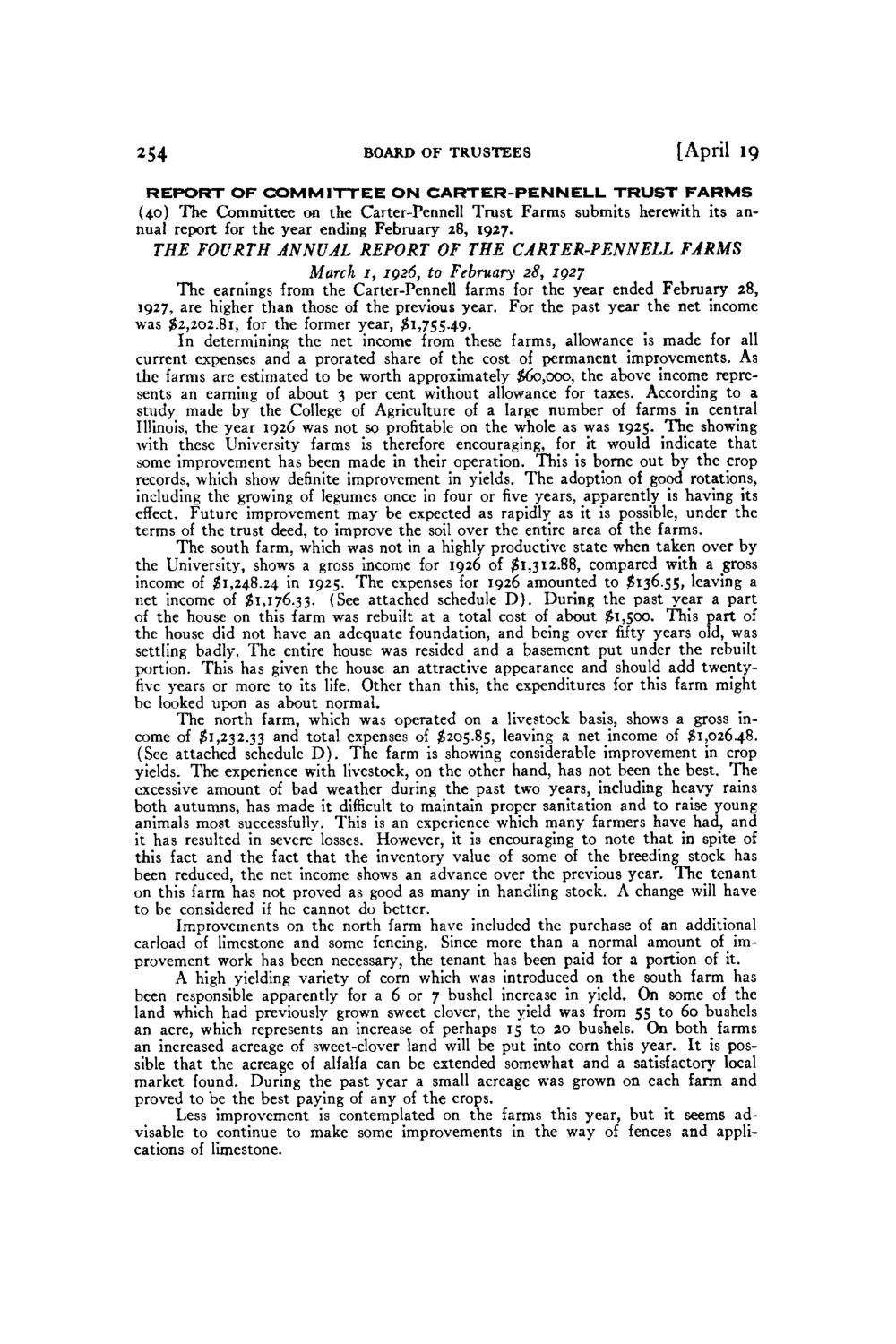| |
| |
Caption: Board of Trustees Minutes - 1928
This is a reduced-resolution page image for fast online browsing.

EXTRACTED TEXT FROM PAGE:
254 BOARD OF TRUSTEES [April 19 REPORT OF COMMITTEE ON CARTER-PENNELL TRUST FARMS (40) The Committee on the Carter-Pennell Trust Farms submits herewith its annual report for the year ending February 28, 1927. THE FOURTH ANNUAL REPORT OF THE CARTER-PENNELL FARMS March 1, 1926, to February 28, 1927 The earnings from the Carter-Pennell farms for the year ended February 28, 1927, are higher than those of the previous year. For the past year the net income was $2,202.81, for the former year, $1,75549. In determining the net income from these farms, allowance is made for all current expenses and a prorated share of the cost of permanent improvements. A s the farms are estimated to be worth approximately $60,000, the above income represents an earning of about 3 per cent without allowance for taxes. According to a study made by the College of Agriculture of a large number of farms in central Illinois, the year 1926 was not so profitable on the whole as was 1925. The showing with these University farms is therefore encouraging, for it would indicate that some improvement has been made in their operation. This is b o m e out by the crop records, which show definite improvement in yields. The adoption of good rotations, including the growing of legumes once in four or five years, apparently is having its effect. Future improvement m a y be expected as rapidly as it is possible, under the terms of the trust deed, to improve the soil over the entire area of the farms. The south farm, which was not in a highly productive state when taken over by the University, shows a gross income for 1926 of $1,312.88, compared with a gross income of $1,248.24 in 1925. The expenses for 1926 amounted to $136.55, leaving a net income of $1,176.33. (See attached schedule D ) . During the past year a part of the house on this farm was rebuilt at a total cost of about $1,500. This part of the house did not have an adequate foundation, and being over fifty years old, was settling badly. The entire house was resided and a basement put under the rebuilt portion. This has given the house an attractive appearance and should add twentyfive years or more to its life. Other than this, the expenditures for this farm might be looked upon as about normal. The north farm, which was operated on a livestock basis, shows a gross income of $1,232.33 and total expenses of $205.85, leaving a net income of $1,026.48. (See attached schedule D ) . The farm is showing considerable improvement in crop yields. The experience with livestock, on the other hand, has not been the best. The excessive amount of bad weather during the past two years, including heavy rains both autumns, has made it difficult to maintain proper sanitation and to raise young animals most successfully. This is an experience which many farmers have had, and it has resulted in severe losses. However, it is encouraging to note that in spite of this fact and the fact that the inventory value of some of the breeding stock has been reduced, the net income shows an advance over the previous year. The tenant on this farm has not proved as good as many in handling stock. A change will have to be considered if he cannot do better. Improvements on the north farm have included the purchase of an additional carload of limestone and some fencing. Since more than a normal amount of improvement work has been necessary, the tenant has been paid for a portion of it. A high yielding variety of corn which was introduced on the south farm has been responsible apparently for a 6 or 7 bushel increase in yield. O n some of the land which had previously grown sweet clover, the yield was from 55 to 60 bushels an acre, which represents an increase of perhaps 15 to 20 bushels. O n both farms an increased acreage of sweet-clover land will be put into corn this year. It is possible that the acreage of alfalfa can be extended somewhat and a satisfactory local market found. During the past year a small acreage was grown on each farm and proved to be the best paying of any of the crops. Less improvement is contemplated on the farms this year, but it seems advisable to continue to make some improvements in the way of fences and applications of limestone.
| |